This site uses cookies as defined in our Cookie Policy, by continuing to use this site you agree to their use.
Continue
| Arrive | Depart | ||||||
| 27th27 | FebFeb | 202828 | Rio de Janeiro, Brazil, embark on the Silver Shadow | ||||
Welcome to the Cidade Maravilhosa, or the Marvelous City, as Rio is known in Brazil. Synonymous with the girl from Ipanema, the dramatic views from Christ the Redeemer atop Corcovado mountain, and fabulously flamboyant Carnival celebrations, Rio is a city of stunning architecture, abundant museums, and marvelous food. Rio is also home to 23 beaches, an almost continuous 73-km (45-mile) ribbon of sand.As you leave the airport and head to Rio's beautiful Zona Sul (the touristic South Zone), you'll drive for about 40 minutes on a highway from where you'll begin to get a sense of the dramatic contrast between beautiful landscape and devastating poverty. In this teeming metropolis of 12 million people (6.2 million of whom live in Rio proper), the very rich and the very poor live in uneasy proximity. You'll drive past seemingly endless cinder-block favela, but by the time you reach Copacabana's breezy, sunny Avenida Atlântica—flanked on one side by white beach and azure sea and on the other by condominiums and hotels—your heart will leap with expectation as you begin to recognize the postcard-famous sights. Now you're truly in Rio, where cariocas (Rio residents) and tourists live life to its fullest.Enthusiasm is contagious in Rio. Prepare to have your senses engaged and your inhibitions untied. Rio seduces with a host of images: the joyous bustle of vendors at Sunday's Feira Hippie (Hippie Fair); the tipsy babble at sidewalk cafés as patrons sip their last glass of icy beer under the stars; the blanket of lights beneath the Pão de Açúcar (Sugarloaf Mountain); the bikers, joggers, strollers, and power walkers who parade along the beach each morning. Borrow the carioca spirit for your stay; you may find yourself reluctant to give it back. Lie back on the golden sands to soak up the extraordinary setting - or watch on as muscled cariocas - locals - perform effortless athletic feats, during casual volleyball matches. A trip up to Rio de Janeiro’s iconic art-deco statue of Christ the Redeemer is, of course, a must do - offering an extraordinary view of the city rolling out before your eyes. You’ll also want to take a cable car to swing by the top of Sugarloaf Mountain, which juts sharply into the sky from nowhere. Brazil’s second largest city moves to an infectious samba beat, and the famous thumping Carnival floods colour and floats down its streets each year. Of course, Rio is also a city of sharp cultural contrasts – offering fun in the sun for some, while life goes on very much as it always has for others. Take a guided tour, led by a resident, to see the conditions inside these complex tapestries of colour and chaos first-hand. Tijuca National Park, offers easy-to-access tranquillity, immersing you in dense forestry and whopping birdsong. Later, watch the fiery shades of sunset spread across the sky in the city’s oh so famous evening light show. With so much to offer, you’ll quickly learn how Rio earned its other name ‘Cidade Maravilhosa’ – The Marvellous City. | |||||||
| 28th28 | FebFeb | 202828 | Rio de Janeiro, Brazil | 23:00 | |||
Welcome to the Cidade Maravilhosa, or the Marvelous City, as Rio is known in Brazil. Synonymous with the girl from Ipanema, the dramatic views from Christ the Redeemer atop Corcovado mountain, and fabulously flamboyant Carnival celebrations, Rio is a city of stunning architecture, abundant museums, and marvelous food. Rio is also home to 23 beaches, an almost continuous 73-km (45-mile) ribbon of sand.As you leave the airport and head to Rio's beautiful Zona Sul (the touristic South Zone), you'll drive for about 40 minutes on a highway from where you'll begin to get a sense of the dramatic contrast between beautiful landscape and devastating poverty. In this teeming metropolis of 12 million people (6.2 million of whom live in Rio proper), the very rich and the very poor live in uneasy proximity. You'll drive past seemingly endless cinder-block favela, but by the time you reach Copacabana's breezy, sunny Avenida Atlântica—flanked on one side by white beach and azure sea and on the other by condominiums and hotels—your heart will leap with expectation as you begin to recognize the postcard-famous sights. Now you're truly in Rio, where cariocas (Rio residents) and tourists live life to its fullest.Enthusiasm is contagious in Rio. Prepare to have your senses engaged and your inhibitions untied. Rio seduces with a host of images: the joyous bustle of vendors at Sunday's Feira Hippie (Hippie Fair); the tipsy babble at sidewalk cafés as patrons sip their last glass of icy beer under the stars; the blanket of lights beneath the Pão de Açúcar (Sugarloaf Mountain); the bikers, joggers, strollers, and power walkers who parade along the beach each morning. Borrow the carioca spirit for your stay; you may find yourself reluctant to give it back. Lie back on the golden sands to soak up the extraordinary setting - or watch on as muscled cariocas - locals - perform effortless athletic feats, during casual volleyball matches. A trip up to Rio de Janeiro’s iconic art-deco statue of Christ the Redeemer is, of course, a must do - offering an extraordinary view of the city rolling out before your eyes. You’ll also want to take a cable car to swing by the top of Sugarloaf Mountain, which juts sharply into the sky from nowhere. Brazil’s second largest city moves to an infectious samba beat, and the famous thumping Carnival floods colour and floats down its streets each year. Of course, Rio is also a city of sharp cultural contrasts – offering fun in the sun for some, while life goes on very much as it always has for others. Take a guided tour, led by a resident, to see the conditions inside these complex tapestries of colour and chaos first-hand. Tijuca National Park, offers easy-to-access tranquillity, immersing you in dense forestry and whopping birdsong. Later, watch the fiery shades of sunset spread across the sky in the city’s oh so famous evening light show. With so much to offer, you’ll quickly learn how Rio earned its other name ‘Cidade Maravilhosa’ – The Marvellous City. | |||||||
| 29th29 | FebFeb | 202828 | At Sea | ||||
| 1st01 | MarMar | 202828 | At Sea | ||||
| 2nd02 | MarMar | 202828 | Salvador de Bahia, Brazil | 08:00 | 18:00 | ||
According to Salvador's adopted son Jorge Amado, "In Salvador, magic becomes part of the every-day." From the shimmering golden light of sunset over the Baía do Todos os Santos, to the rhythmic beats that race along the streets, Salvador, while no longer Brazil's capital, remains one of its most captivating cities. A large dose of its exoticism comes down to its African heritage—at least 70% of its 2,675,000 population is classified as Afro-Brazilian—and how it has blended into Brazil's different strands, from the native Indians to the Christian colonizers. Salvadorans may tell you that you can visit a different church every day of the year, which is almost true—the city has about 300. Churches whose interiors are covered with gold leaf were financed by the riches of the Portuguese colonial era, when slaves masked their traditional religious beliefs under a thin Catholic veneer. And partly thanks to modern-day acceptance of those beliefs, Salvador has become the fount of Candomblé, a religion based on personal dialogue with the orixás, a family of African deities closely linked to nature and the Catholic saints. The influence of Salvador's African heritage on Brazilian music has also turned the city into one of the musical capitals of Brazil, resulting in a myriad of venues to enjoy live music across the city, along with international acclaim for exponents like Gilberto Gil, Caetano Veloso, and Daniela Mercury. Salvador's economy today is focused on telecommunications and tourism. The still-prevalent African culture draws many tourists—this is the best place in Brazil to hear African music, learn or watch African dance, and see capoeira, a martial art developed by slaves. In the district of Pelourinho, many colorful 18th- and 19th-century houses remain, part of the reason why this is the center of the tourist trade. Salvador sprawls across a peninsula surrounded by the Baía de Todos os Santos on one side and the Atlantic Ocean on the other. The city has about 50 km (31 miles) of coastline. The original city, referred to as the Centro Histórica (Historical Center), is divided into the Cidade Alta (Upper City), also called Pelourinho, and Cidade Baixa (Lower City). The Cidade Baixa is a commercial area—known as Comércio—that runs along the port and is the site of Salvador's indoor market, Mercado Modelo. You can move between the upper and lower cities on foot, via the landmark Elevador Lacerda, behind the market, or on the Plano Inclinado, a funicular lift, which connects Rua Guindaste dos Padres on Comércio with the alley behind Cathedral Basílica. From the Cidade Histórica you can travel north along the bay to the hilltop Igreja de Nosso Senhor do Bonfim. You can also head south to the point, guarded by the Forte Santo Antônio da Barra, where the bay waters meet those of the Atlantic. This area on Salvador's southern tip is home to the trendy neighborhoods of Barra, Ondina, and Rio Vermelho, with many museums, theaters, shops, and restaurants. Beaches along the Atlantic coast and north of Forte Santo Antônio da Barra are among the city's cleanest. Many are illuminated at night and have bars and restaurants that stay open late. A multicultured, multifaceted place, discover brilliant beach life, airy colonial plazas and infectious samba rhythms as you explore this Brazillian melting pot. Sat on a scenic peninsula, idyllic beaches coat the city on three sides, and a historic fort sits just offshore, watching the waters menacingly. One of the world’s biggest carnivals is thrown towards the end of February, but don’t worry if you miss it – there's always an excuse to celebrate something in Salvador de Bahia. The old town – with its lemon and duck egg blue colours - rises above the city, peppered with gold-leaf flourishes and carved historical churches. Pelourinho street is one of the town's most dazzling - a picturesque gathering of bright hues and uneven cobbled streets. Bahia’s capital and largest city was Brazil's first capital, built on the backs of slaves imported from Africa. Since then the cultures have fused to create a vibrant Afro-Brazilian cocktail. Moqueca is the local flavour here, a slow-cooked stew of coconut milk, seafood and bell peppers, its a creamy and delicious indulgence with a chilli kick. Enjoy a spot of relaxation on the city's beaches - and see a relatively rare phenomenon in Brazil - sunset dipping over the sea's waves, on the sands of the westerly facing Porto da Barra. Or, escape the crowds and recline below swaying coconut palms on the golden sands of beaches reaching up to the north, which are some of Brazil’s most picturesque and secluded. | |||||||
| 3rd03 | MarMar | 202828 | At Sea | ||||
| 4th04 | MarMar | 202828 | At Sea | ||||
| 5th05 | MarMar | 202828 | At Sea | ||||
| 6th06 | MarMar | 202828 | At Sea | ||||
| 7th07 | MarMar | 202828 | At Sea | ||||
| 8th08 | MarMar | 202828 | Saint Helena, Saint Helena, Ascension and Tristan da Cunha | 08:00 | 18:00 | ||
St Helena is a tiny, remote island lying in the South Atlantic, and thanks to its isolation it has a rare and unspoilt beauty. The nearest land is Ascension Island, situated some 700 miles north-west of St Helena, and the nearest mainland, West Africa, is over 1,000 miles away. The island was discovered by Juan de Nova Castella on May 21, 1502 and subsequently became a stop-off point for Portuguese vessels to replenish their supplies and break long voyages. In 1676 the famous astonomer Edmund Haley arrived in St Helena to produce his 'Catalogue of the Stars in the Southern Hemisphere'. However, the island is perhaps best known as the final exile of Napoleon Bonaparte. Following his defeat at Waterloo in 1815, Napoleon was exiled to Longwood House where he remained until his death six years later in 1821. Although primarily known as the island where Napoleon was exiled after his defeat at Waterloo, the fascination with St. Helena goes back many more centuries. Its main attraction may very well be its remoteness, which enabled the Portuguese to keep their discovery of the island in 1502 a secret for the next 80 years. It was this isolated location that the British thought perfect to keep the defeated Napoleon. St. Helena, a "green gem set in a ring of bronze", as a poet once called it, is surrounded by a magnificent coastline, with 1,000-foot-high cliffs dropping down to rocks pounded by the Atlantic surf. The countryside offers astonishing contrasts, ranging from wind-eroded desert with multicolored ridges and valleys to flax and tree covered hillsides, soft pastures and vegetation-filled valleys. Jamestown is the island's tiny capital and only town, boasting a number of 18th- and 19th-century buildings. Other attractions include Jacob's Ladder, 699 steps leading from the valley floor to the top of Ladder Hill. Exploring Jamestown is like a delightful treasure hunt. The garden of Plantation House, the governor's residence, is a favorite with visitors because of the giant tortoises that live on the grounds (one of which is reputedly 200 years old). Equally popular is Longwood House, where Napoleon spent the final six years of his life in exile. Because of the island's remoteness, even in today's jet age the only way to get there is by sea. Visiting St. Helena is rather like going back in time. Despite electricity, paved roads and cars, the island has retained a way of life reminiscent of bygone days. The 5,500 islanders are British and proud of it. Tuna and wahoo fishing add much to the island's economy and serves as a recreational sport to the resident. Soccer is the most popular game followed by cricket and tennis. The golf course at Longwood is pleasant, but not championship material. The island is visited approximately six times a year by a shipping service en route from England to South Africa. On these calls and the occasional call of a cruise vessel, the old wharf and tiny Jamestown come to life and both residents and visitors thoroughly enjoy this exciting event. | |||||||
| 9th09 | MarMar | 202828 | At Sea | ||||
| 10th10 | MarMar | 202828 | At Sea | ||||
| 11th11 | MarMar | 202828 | At Sea | ||||
| 12th12 | MarMar | 202828 | Walvis Bay, Namibia | ||||
Once a whaling station, Walvis Bay provides a gateway to the extraordinary desert landscapes of Namibia and is itself an area of unusual natural beauty. The showpiece of the Walvis Bay area is the natural lagoon where you can see flamingos in their thousands at certain times of the year, along with a variety of other wading birds such as the white pelican. Further inland you will find the stunning Namib Desert, which provides an unlikely home for a diverse array of wildlife. Alternatively, you could venture into the desert of Sossusvlei, whose mountainous ochre sand dunes are said to be the highest in the world, or visit the colonial town of Swakopmund. Home to a beautiful lagoon washed pale pink by a colony of resident flamingos Walvis Bay is a colourful African call where you can meet some of the continent’s most flamboyant wildlife. A small Namibian city on the Atlantic coast of southern Africa the city takes its name from Whale Bay - which gives a clue as to the wonderful wildlife watching opportunities available here. As Namibia’s only deep-water harbour Walvis Bay is an important fishing centre for the country and its sunny shores and natural wonders make it a popular spot for holidaymakers. Walvis Bay is a bird lover's paradise and hundreds of thousands of birds assemble here to make the most of the tidal lagoon. Boat tours can take you out amongst the preening crowds or you can admire the flamingos herons and carefully treading wading bird species from afar. With whales and dolphins frolicking offshore too there’s a wide variety of wildlife to see here. On the cusp of the sun-scorched Namib Desert beyond Dune 7 rises up to form the highest sand dune in the country with sands piling up 380 metres. Perfect for a picnic or a pulse-raising desert sport like sand skiing or sandboarding. Climb to the top for views from its heights or you can take a flight tour to see further afield and spot some of the extraordinary land animals who roam the landscapes. See the natural drama of Sandwich Harbour where the golden sand dunes plummet directly into the ocean’s waves. | |||||||
| 13th13 | MarMar | 202828 | Walvis Bay, Namibia | 13:00 | |||
Once a whaling station, Walvis Bay provides a gateway to the extraordinary desert landscapes of Namibia and is itself an area of unusual natural beauty. The showpiece of the Walvis Bay area is the natural lagoon where you can see flamingos in their thousands at certain times of the year, along with a variety of other wading birds such as the white pelican. Further inland you will find the stunning Namib Desert, which provides an unlikely home for a diverse array of wildlife. Alternatively, you could venture into the desert of Sossusvlei, whose mountainous ochre sand dunes are said to be the highest in the world, or visit the colonial town of Swakopmund. Home to a beautiful lagoon washed pale pink by a colony of resident flamingos Walvis Bay is a colourful African call where you can meet some of the continent’s most flamboyant wildlife. A small Namibian city on the Atlantic coast of southern Africa the city takes its name from Whale Bay - which gives a clue as to the wonderful wildlife watching opportunities available here. As Namibia’s only deep-water harbour Walvis Bay is an important fishing centre for the country and its sunny shores and natural wonders make it a popular spot for holidaymakers. Walvis Bay is a bird lover's paradise and hundreds of thousands of birds assemble here to make the most of the tidal lagoon. Boat tours can take you out amongst the preening crowds or you can admire the flamingos herons and carefully treading wading bird species from afar. With whales and dolphins frolicking offshore too there’s a wide variety of wildlife to see here. On the cusp of the sun-scorched Namib Desert beyond Dune 7 rises up to form the highest sand dune in the country with sands piling up 380 metres. Perfect for a picnic or a pulse-raising desert sport like sand skiing or sandboarding. Climb to the top for views from its heights or you can take a flight tour to see further afield and spot some of the extraordinary land animals who roam the landscapes. See the natural drama of Sandwich Harbour where the golden sand dunes plummet directly into the ocean’s waves. | |||||||
| 14th14 | MarMar | 202828 | Lüderitz, Namibia | 08:00 | 18:00 | ||
The reopening of the diamond mine at Elizabeth Bay 20 years ago has brought the development of tourism and fishing back to this small 19th century village on the barren, windswept Namib Desert coast. One of Namibias oddities, it has everything you'd expect from a small German town - delicatessens, coffee shops and a Lutheran church. Here, the icy but clean South Atlantic is home to seals, penguins and other marine life and the desolate beaches support flamingoes. It was founded in 1883 when Heinrich Vogelsang purchased Angra Pequena and some of the surrounding land on behalf of Adolf Lüderitz, a Hanseat from Germany, from the local Nama chief. Lüderitz began its life as a trading post, with other activities in fishing and guano-harvesting. As a sign of Luderitz's revival, 1996 staged the first traditional German Karneval since 1960. The scorched desert that surrounds Luderitz means the city’s collection of German art nouveau architecture couldn't look more unusually placed along the Namibian coastline. This quirkiness is what gives the destination its charm. See gangs of playful penguins skipping across the waves pink flamingos wading by the coast and dolphins leaping into the air near Penguin Island and Seal Island. A much more haunting location with an incredibly dark past is Shark Island - which witnessed the deaths of between 1 000 and 3 000 people when it was the location of a German concentration camp between 1905 and 1907. Inland from Luderitz is Kolmanskop the site of a famous diamond mine and ghost town. | |||||||
| 15th15 | MarMar | 202828 | At Sea | ||||
| 16th16 | MarMar | 202828 | Cape Town, South Africa | ||||
Sometimes referred to as the Mother City, Cape Town is the most famous port in South Africa and is influenced by many different cultures, including Dutch, British and Malay. The port was founded in 1652 by Dutch explorer Jan Van Riebeeck, and evidence of Dutch colonial rule remains throughout the region. The port is located on one of the world's most important trade routes, and is mainly a container port and handler of fresh fruit. Fishing is another vital industry, with large Asian fishing fleets using Cape Town as a logistical repair base for much of the year. The region is famous for its natural beauty, with the imposing Table Mountain and Lions Head, as well as the many nature reserves and botanical gardens such as Kirstenbosch which boasts an extensive range of indigenous plant life, including proteas and ferns. Cape Town's weather is mercurial, and can change from beautiful sunshine to dramatic thunderstorms within a short period. A local adage is that in Cape Town you can experience four seasons in one day. Sprawling across endless, staggeringly blue coastline, and watched over by the iconic plane of Table Mountain, Cape Town is without doubt one of the world’s most beautiful cities. A blend of spectacular mountain scenery, multiculturalism and relaxed ocean charm awaits in the Mother City, where you can venture out to rolling vineyards, dine in laid back sea suburbs, or spend days exploring cool urban culture. Cape Town’s natural splendour fully reveals itself as the cable car rears sharply to the top of Table Mountain. From the summit, 3,500 feet above sea level, you can let the scale of the panoramic vistas of the city rolling down towards the ocean wash over you. Another heavenly perspective waits at the top of Lion's Head’s tapering peak. A sharp hike and an early start is required, but the views of the morning sun painting Table Mountain honey-gold are some of Cape Town’s finest. Cape Town’s glorious sunshine and inviting blue rollers can be a little deceiving - these oceans are anything but warm at times, with nothing between the peninsula’s end and Antarctica’s icy chill. This cool water has upsides though, bringing a colony of adorably cute African penguins to Boulders Beach. Boarded walkways offer the perfect vantage point to see the cute creatures dipping into the sea and lounging in the sun. Nearby, journey to the end of Africa at the Cape of Good Hope, where you can stand at the bottom of this mighty continent, watching out over the merging waves of the Atlantic and Indian Oceans. Cape Town’s beauty is counterpointed by the ominous island form, which sits four miles offshore from the bustling restaurants and lazy seals of the lively V&A Waterfront. A living history lesson, you can sail in the ships that transported prisoners out to Robben Island, before a former prisoner tells of the traumas of life on this offshore prison. Your guide will show you the cramped cells, and render Mandela’s long walk to freedom in heartbreaking, visceral clarity. | |||||||
| 17th17 | MarMar | 202828 | Cape Town, South Africa, disembark the Silver Shadow | ||||
Sometimes referred to as the Mother City, Cape Town is the most famous port in South Africa and is influenced by many different cultures, including Dutch, British and Malay. The port was founded in 1652 by Dutch explorer Jan Van Riebeeck, and evidence of Dutch colonial rule remains throughout the region. The port is located on one of the world's most important trade routes, and is mainly a container port and handler of fresh fruit. Fishing is another vital industry, with large Asian fishing fleets using Cape Town as a logistical repair base for much of the year. The region is famous for its natural beauty, with the imposing Table Mountain and Lions Head, as well as the many nature reserves and botanical gardens such as Kirstenbosch which boasts an extensive range of indigenous plant life, including proteas and ferns. Cape Town's weather is mercurial, and can change from beautiful sunshine to dramatic thunderstorms within a short period. A local adage is that in Cape Town you can experience four seasons in one day. Sprawling across endless, staggeringly blue coastline, and watched over by the iconic plane of Table Mountain, Cape Town is without doubt one of the world’s most beautiful cities. A blend of spectacular mountain scenery, multiculturalism and relaxed ocean charm awaits in the Mother City, where you can venture out to rolling vineyards, dine in laid back sea suburbs, or spend days exploring cool urban culture. Cape Town’s natural splendour fully reveals itself as the cable car rears sharply to the top of Table Mountain. From the summit, 3,500 feet above sea level, you can let the scale of the panoramic vistas of the city rolling down towards the ocean wash over you. Another heavenly perspective waits at the top of Lion's Head’s tapering peak. A sharp hike and an early start is required, but the views of the morning sun painting Table Mountain honey-gold are some of Cape Town’s finest. Cape Town’s glorious sunshine and inviting blue rollers can be a little deceiving - these oceans are anything but warm at times, with nothing between the peninsula’s end and Antarctica’s icy chill. This cool water has upsides though, bringing a colony of adorably cute African penguins to Boulders Beach. Boarded walkways offer the perfect vantage point to see the cute creatures dipping into the sea and lounging in the sun. Nearby, journey to the end of Africa at the Cape of Good Hope, where you can stand at the bottom of this mighty continent, watching out over the merging waves of the Atlantic and Indian Oceans. Cape Town’s beauty is counterpointed by the ominous island form, which sits four miles offshore from the bustling restaurants and lazy seals of the lively V&A Waterfront. A living history lesson, you can sail in the ships that transported prisoners out to Robben Island, before a former prisoner tells of the traumas of life on this offshore prison. Your guide will show you the cramped cells, and render Mandela’s long walk to freedom in heartbreaking, visceral clarity. | |||||||
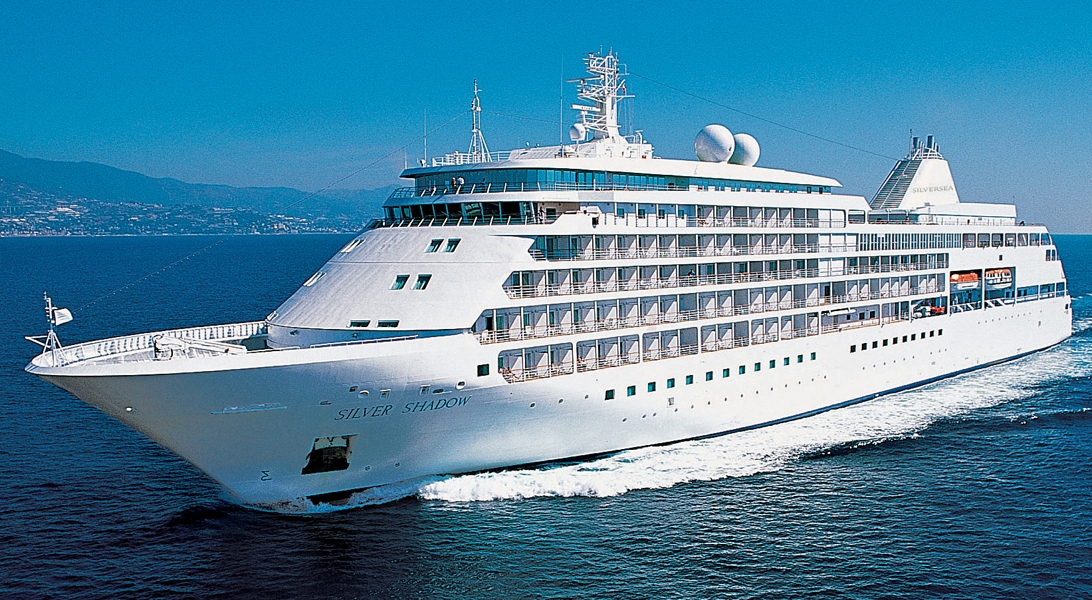







The images shown are for illustration purposes only and may not be an exact representation of what you find on the ship.
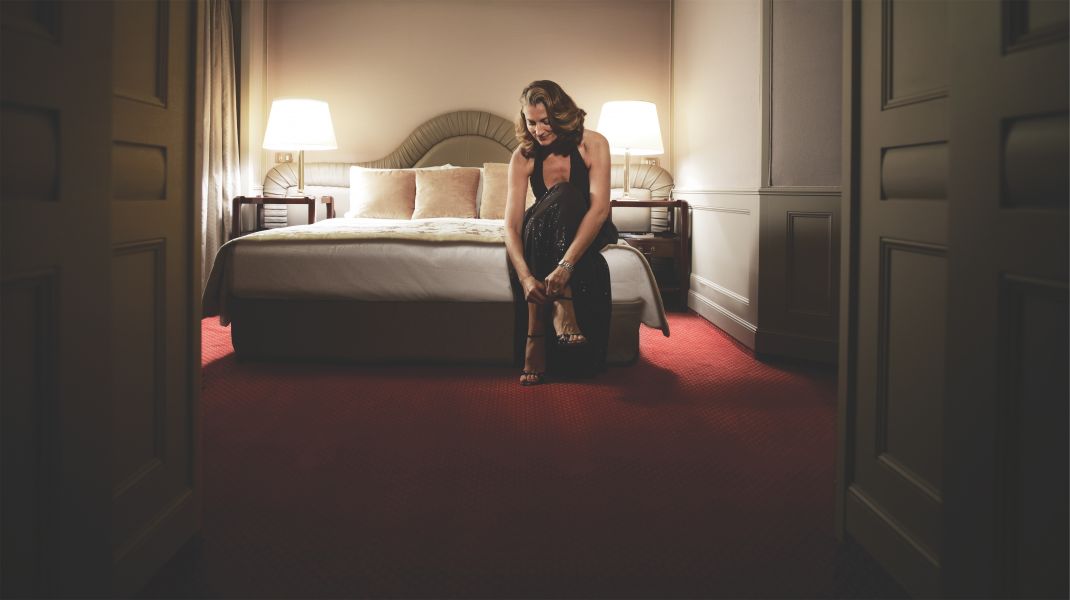
| Grade Code | From | To | |
| G1 | Grand Suite (1 Bedroom) | £21,600 | £21,900 |
| G2 | Grand Suite (2 Bedrooms) | £29,300 | £29,900 |
Expertly designed and exquisitely appointed. Ideal for entertaining friends while you cruise or enjoying a quiet dinner “at home”. Available as a one-bedroom configuration or as two-bedrooms (as illustrated) by adjoining with a Silversea Veranda Suite.
One bedroom: 87-101 sq.m. including veranda
Two bedroom: 133 sq.m. including veranda
Please note that the 3rd guest will sleep on a comfortable sofa bed in the reception area of the suite.
Essentials
Characteristics
Furniture
Media & Communication
Onboard Services
Amenities
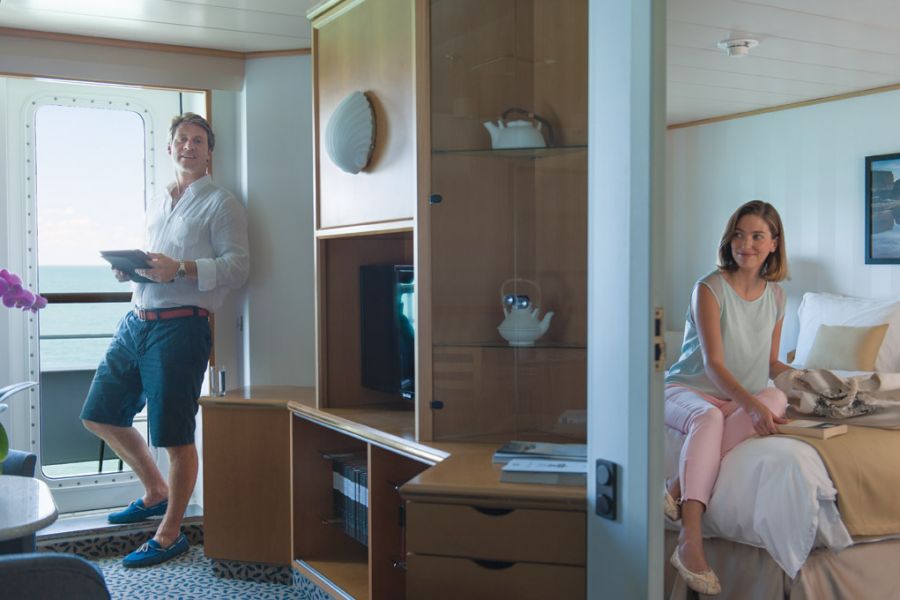
| Grade Code | From | To | |
| ME | Medallion Suite | £15,600 | £15,900 |
A mark of distinction. Sumptuous. Spacious. Rich textures and panoramic views surround you with distinguished luxury. An extravagant suite for an extravagant cruise.
One bedroom: 49 sq.m. including veranda
Please note that the 3rd guest will sleep on a comfortable sofa bed in the reception area of the suite.
Essentials
Characteristics
Furniture
Media & Communication
Onboard Services
Amenities
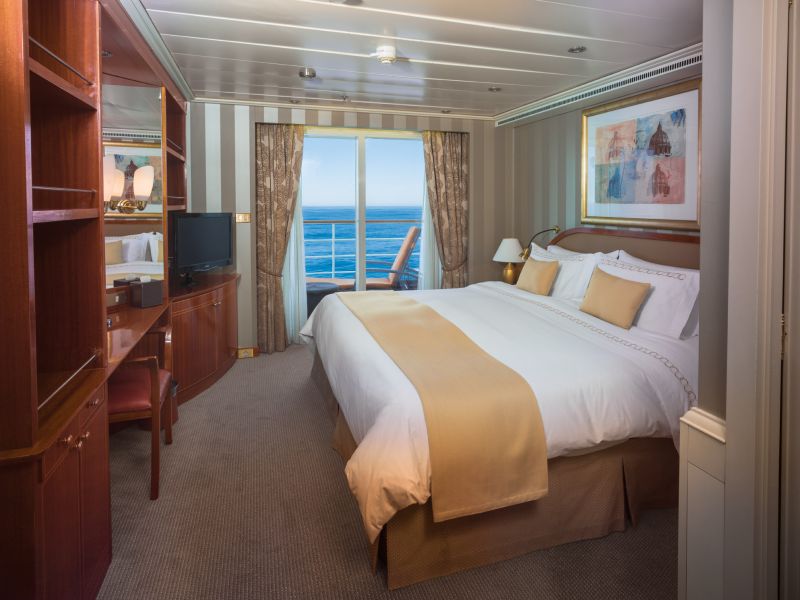
| Grade Code | From | To | |
| O1 | Owner's Suite (1 Bedroom) | £23,300 | £23,600 |
| O2 | Owner's Suite (2 Bedrooms) | £29,600 | £30,200 |
The name Owner's Suite says it all. A stylish apartment. Prestigious and classic. For those who seek the superlative level of space, comfort and service on board. Available as a one-bedroom configuration or as two-bedrooms (as illustrated) by adjoining with a Vista Suite.
One bedroom: 85 sq.m. including veranda
Two bedroom: 117 sq.m. including veranda
Please note that the 3rd guest will sleep on a comfortable sofa bed in the reception area of the suite.
Essentials
Characteristics
Furniture
Media & Communication
Onboard Services
Amenities
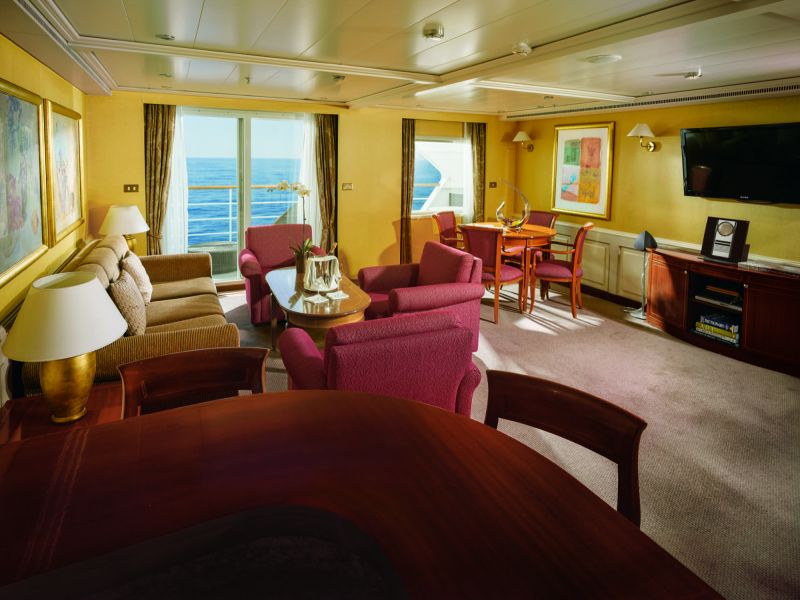
| Grade Code | From | To | |
| R1 | Royal Suite (1 Bedroom) | £19,700 | £20,000 |
| R2 | Royal Suite (2 Bedrooms) | £27,400 | £28,000 |
Stately describes the Royal Suite. Commanding and majestic. Perfect for entertaining. Enough living space to roam. The pinnacle of good living. Available as a one-bedroom configuration or as two-bedrooms (as illustrated) by adjoining with a Veranda Suite.
One bedroom: 90-94 sq.m. including veranda
Two bedroom: 126 sq.m. including veranda
Please note that the 3rd guest will sleep on a comfortable sofa bed in the reception area of the suite.
Essentials
Characteristics
Furniture
Media & Communication
Onboard Services
Amenities
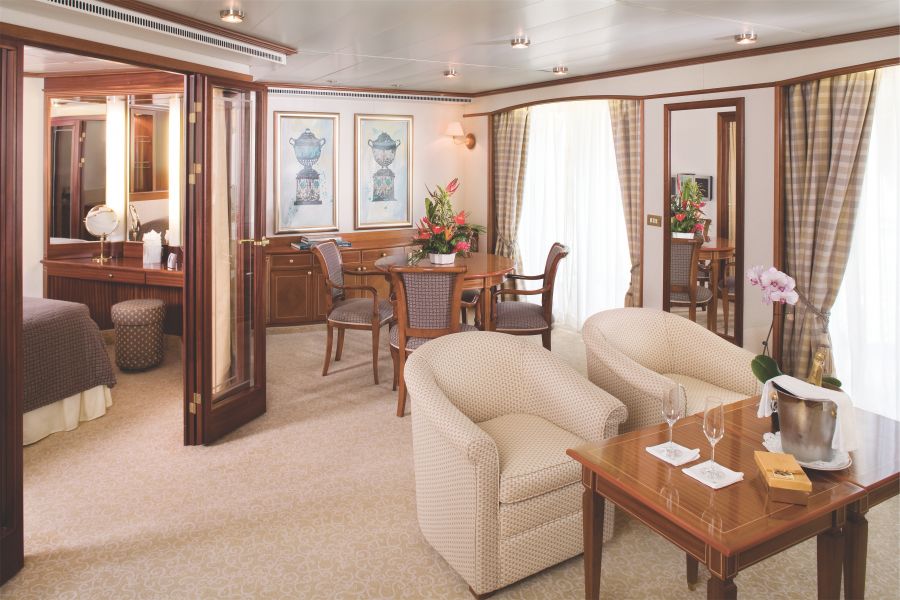
| Grade Code | From | To | |
| SL | Silver Suite | £17,600 | £17,900 |
Stylish and sophisticated. Separate dining and living rooms. Larger verandas. Situated midship. Perfection in design for comfortable living. Silver Suites accommodate three guests.
One bedroom: 61-65 sq.m. including veranda
Please note that the 3rd guest will sleep on a comfortable sofa bed in the reception area of the suite.
Essentials
Characteristics
Furniture
Media & Communication
Onboard Services
Amenities
The images shown are for illustration purposes only and may not be an exact representation of what you find on the ship.

Authentic Italian recipes and the freshest, sustainable ingredients come together in this restaurant at sea.
On board this luxury cruise ship a divine selection of Italy’s best cuisine is served à la carte in La Terrazza. Authentic recipes and the freshest ingredients come together with flair and passion aboard this luxury cruise — a flavourful expression of Silversea’s distinctive Italian heritage. La Terrazza uses buffalo mozzarella from Naples, organic balsamic vinegar and olive oil from Umbria, and air-dried ham out of Parma. The Emilia-Romagna region also produces Silversea’s 24-month aged Parmigiano Reggiano, while the pasta is made daily right on board.
Open seating for breakfast and lunch.
Reservations required for dinner.

Enjoy Continental and regional specialities, as well as sweeping ocean views in our main dining room.
Sparkling with silver, crystal and candlelight, Silversea’s main dining room serves contemporary, international cuisine with sophisticated elegance and impeccable service. Menus feature regional specialities unique to the voyage destination, for example, Roasted Chilean Sea Bass while cruising the Chilean fjords and Indian Chicken Korma en route to Mumbai. The Restaurant aboard this luxury cruise ship offers open-seating dining, which means there are no assigned times, no assigned tables. You are free to dine when, where and with whom you please.
The images shown are for illustration purposes only and may not be an exact representation of what you find on the ship.
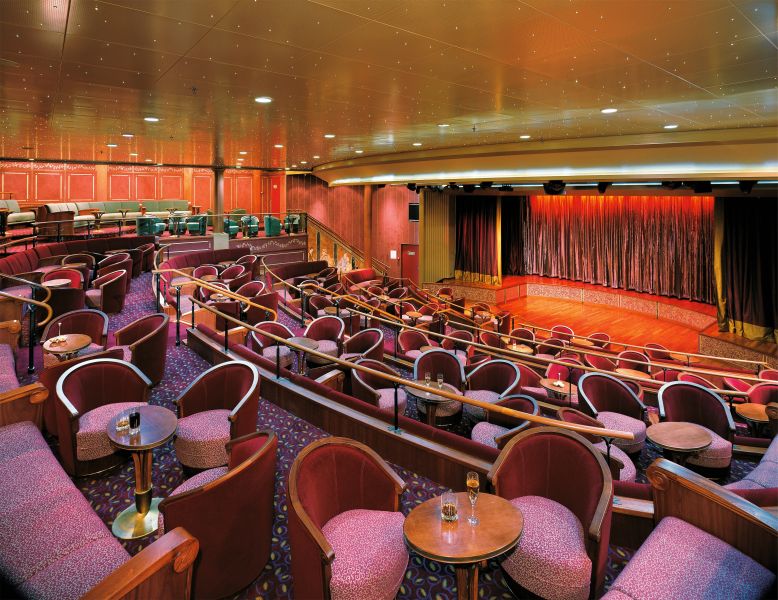
Applaud a broad spectrum of entertainment — from full-scale production shows and classical soloists, to cultural entertainment and feature films.
Every seat in this multi-tiered venue enjoys a clear view to the stage. Applaud a broad spectrum of entertainment presented during the cruise — from full-scale production shows and classical soloists, to cultural entertainment and feature films. Throughout your voyage, the luxury cruise ship’s The Show Lounge also presents port talks, enrichment lectures and a variety of special events.
The images shown are for illustration purposes only and may not be an exact representation of what you find on the ship.
The images shown are for illustration purposes only and may not be an exact representation of what you find on the ship.
| 19 nights aboard the Silver Shadow | |||
| Butler Service in Every Suite | |||
| Gratuities Always Included | |||
| Beverages In-Suite and Throughout the Ship | |||
| Gourmet Dining | |||
| In Suite Dining & 24-Hour Room Service | |||
| Intimate small size ships | |||
| Free Wifi Throughout the Ship | |||
| Free Zodiac, Land and Sea Tours & Activities & Complimentary Expedition gear | |||
| Port Taxes and Fees | |||
 | ABTA and ATOL Protection* | ||
Date 27th Feb 2028 |
Nts 19 |
Suite £8,100pp |
Date 27th Feb 2028 |
Nts 19 |
Suite £8,100pp |
| Suite staterooms from | £8,100pp | ||
| G1 | Grand Suite (1 Bedroom) |  | |
| G2 | Grand Suite (2 Bedrooms) |  | |
| ME | Medallion Suite |  | |
| O1 | Owner's Suite (1 Bedroom) |  | |
| O2 | Owner's Suite (2 Bedrooms) |  | |
| R1 | Royal Suite (1 Bedroom) | £19,700pp | |
| R2 | Royal Suite (2 Bedrooms) |  | |
| SL | Silver Suite |  | |
| VI | Vista Suite |  | |
| CV | Classic Veranda Suite | £8,100pp | |
| DX | Deluxe Veranda Suite | £8,900pp | |
| SV | Superior Veranda Suite | £8,500pp | |
Fusion Cruises when selling travel arrangements is a trading name of The Midcounties Co-operative Ltd. Fusion Cruises is an Accredited Body Member of Midcounties Co-operative Travel Consortium. (ABTA:P6652, ATOL:6053).
Book with Confidence. We are a Member of ABTA which means you have the benefit of ABTA’s assistance and Code of Conduct.
Some of the flights and flight-inclusive holidays on this website are financially protected by the ATOL scheme but ATOL protection does not apply to all holiday and travel services offered on this website. This website will provide you with information on the protection that applies in the case of each holiday and travel service offered before you make your booking. If you do not receive an ATOL Certificate then the booking will not be ATOL protected. If you do receive an ATOL Certificate but all parts of your trip are not listed on it, those parts will not be ATOL protected. Please see our booking conditions for information, or for more information about financial protection and the ATOL Certificate go to: www.caa.co.uk
